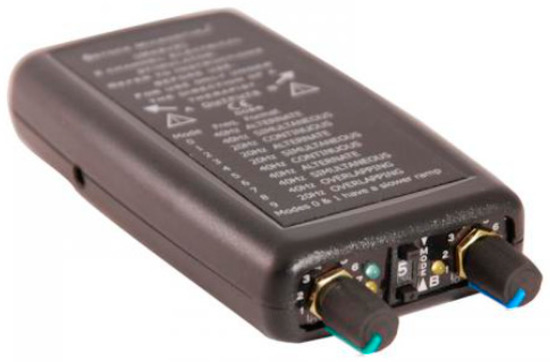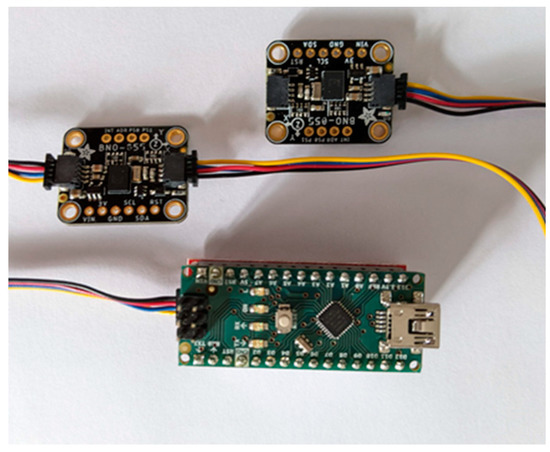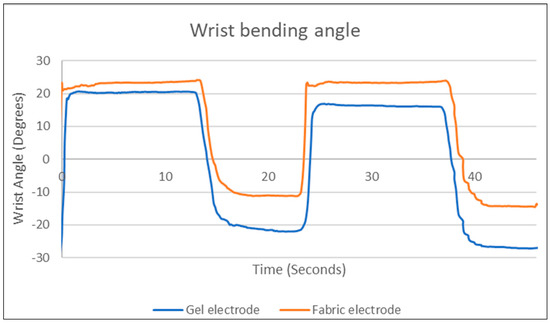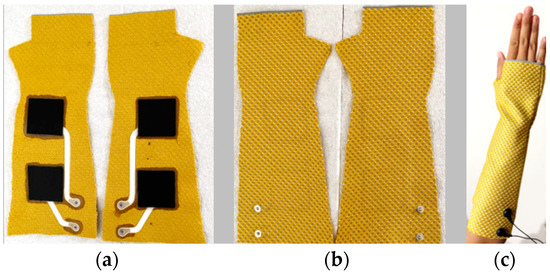I like this out of the box thinking, now just add measurements in there that will objectively tell what the disabilities are. Then we could map the protocols that fix those disabilities and get survivors recovered. See how fucking simple this is?
Design and Test of E-Textiles for Stroke Rehabilitation
1
Electronics and Computer Science, University of Southampton, Southampton SO17 IBJ, UK
2
Winchester School of Art, University of Southampton, Southampton SO23 8DL, UK
3
Odstock Medical Ltd., Salisbury SP2 8BJ, UK
*
Author to whom correspondence should be addressed.
†
Presented at the 4th International
Conference on the Challenges, Opportunities, Innovations and
Applications in Electronic Textiles, Nottingham, UK, 8–10 November 2022.
Eng. Proc. 2023, 30(1), 16; https://doi.org/10.3390/engproc2023030016
Published: 6 February 2023
Abstract
This work presents the design and test of an
e-textile based functional electrical stimulation system for post-stroke
upper limb rehabilitation. The prototype was tested on five stroke
survivors to assess stimulation comfort, the stimulation intensity
required to achieve hand opening, and ease of use. Wrist extension was
measured using two inertial measurement units. The wearable e-textile
prototype achieved similar stimulation comfort compared to high-quality
hydrogel electrodes with a score difference of between 0 and 1. The
stimulation intensity to achieve full hand opening was the same for the
hydrogel electrodes and the e-textiles for all five participants. A
second design based on a knitted sleeve has been assessed in terms of
usability. Additional new designs have been proposed to improve the
usability.
1. Introduction
Stroke
occurs when there is a blockage or bleeding of the blood vessels
affecting the supply of blood to the brain. There are 1.3 million stroke
survivors in the UK [1] and stroke costs the UK National Health Service and wider society £26 billion per annum [2].
Over half of stroke survivors have weak arm/hand movement affecting
their independence and quality of life. Functional Electrical
Stimulation (FES) is a technology used for stroke rehabilitation. It
applies a safe electrical impulse through electrodes placed on the skin
to strengthen weak muscles and improve movement functions. FES has been
used to exercise muscles and assist walking for people with mobility
issues since the 1960s [3]. Systematic reviews with meta-analysis have concluded that FES improves the ability to perform activities [4,5,6].
Existing FES products are difficult to set-up by stroke survivors
without help from their carers or healthcare professionals which
significantly constrains usage. Our previous work has received positive
feedback regarding wearable e-textile FES for home-based stroke
rehabilitation [7].
This work presents the test results of a fabric electrode based
wearable FES in terms of user comfort, stimulation intensity, and
functional movement (wrist extension for hand opening) on five stroke
survivors (ethics approval ID: University of Southampton ERGO 70296).
Ease of use has been assessed. A second knitted design has been assessed
and additional new designs to improve the usability have been proposed
for future study.
2. Materials and Methods
2.1. Electrodes
Wearable
electrodes (5 cm × 5 cm) were fabricated by stacking in turn: a
non-woven fabric, conductive wires leading to a connector, a conductive
carbon film and a carbon rubber electrode layer. Encapsulating the edges
holds the entire assembly together. The electrode was attached to a
fabric arm band as shown in Figure 1. The wearable electrodes were compared with commercial high quality hydrogel electrodes (PALS, Axelgaard, Fallbrook, CA, USA).
2.2. FES
The OML Microstim 2V2 neuromuscular stimulator (Figure 2)
was used in this study. Stimulation was set-up by a clinician to
optimise the electrode positions and stimulation intensity. Water was
sprayed on the electrodes and the skin before applying the fabric
electrode to improve user comfort and stimulation effectiveness.
Stimulation comfort was rated in a scale from 0 to 10 with 0 is the most
comfortable and 10 being very painful. The stimulation intensity was
recorded.
2.3. Inertial Measurement Unit (IMU) Sensors for Wrist Bending Measurement
The wrist angle was measured using a pair of BNO055 IMU sensor breakouts from Adafruit (Figure 3)
which reports the absolute angular position of the sensor. The IMUs
were attached to the user by using Velcro straps with one attached to
the hand and the other to the arm. An Arduino Micro was used to gather
the data from the sensors and sent it to the computer recording the
data. The computer then calculated the wrist angle by taking the
difference between the two absolute positions from the sensors.
2.4. Usability Test
Participants
were asked to put on and take off both the hydrogel electrodes and
fabric electrode arm bands to assess their capability of using the
products independently.
3. Test Results and Discussion
Five participants were recruited for the testing. Age: 56–76, Years of stroke: 3–17 years. Genders: 1 female and 4 males.
3.1. Stimulation Comfort
All
participants reported the same or similar stimulation comfort with only
0 to 1 score difference between the two electrode types as shown in Table 1.
One participant (P1) reported the fabric electrode was more comfortable
than the hydrogel electrodes. One participant (P4) reported the same
comfort scale. The other three reported the hydrogel electrodes were
more comfortable than fabric electrodes. No pain sensation was reported.
3.2. Stimulation Intensity
There was no difference in the stimulation level required to achieve full hand opening between the two types of electrodes (Table 2).
The required stimulation levels vary from 40 mA to 50 mA. This
indicates the fabric electrodes were as effective as the hydrogel
electrodes in generating a functional movement.
3.3. Wrist Bending Measurement
Wrist
movement was measured during the stimulation. All participants achieved
a similar movement for the two types of electrodes. Figure 4 is a representative example of the wrist bending angle for the two electrode types.
3.4. Usability
Researchers
observed that it was a challenging task for participants to peel off
the hydrogel electrodes from the protective plastic film because the
hydrogel electrodes are very sticky. It was even more challenging for
them to take out the electrodes from the sealed bag and put them back
after use. With the electrode arm band, although all participants were
able to put it on and take it off independently, they found it
challenging to keep the electrode in place because it moved around
before it was fastened and secured in place. In addition, it was
challenging to put the Velcro hook fastener through a loop. All
participants were able to spray water on the electrodes and the arm
using a single hand.
3.5. Second Design: Knitted Sleeve
Two
pairs of electrodes were printed on a knitted fabric made of wool and
Lycra yarns to stimulate muscles for both hand extension and flexion (Figure 5).
The electrode fabric was assembled to form a pull-on sleeve. It was
noticed the electrode sleeve was difficult to put on or take off because
of the strong friction between the electrodes inside the sleeve and the
skin. Discussions with the stroke survivors have indicated that an
open, or partially open structure, would allow the user to put on the
electrode sleeve easily, then tighten the sleeve to ensure the
electrodes and skin contact sufficiently.
4. Conclusions and Future Work
This
work has demonstrated the stimulation comfort and functional movement
delivered by a wearable e-textile activated with the OML FES stimulator
Microstim 2V2. The fabric electrode achieved similar stimulation
performance while providing the advantage of being suitable for wearable
application and offering a long service life. All participants were
able to put on and take off the fabric electrode arm bands
independently, but it is time consuming and a better design is required.
A new design with electrodes printed on a knitted stretchable sleeve
was investigated but it was difficult to put on and take off due to the
friction between the electrodes inside the sleeve and the skin. New
designs, required to improve the ease of use, will be addressed in
future work.
Author Contributions
Conceptualization,
M.L., J.T. and K.Y.; methodology, M.L., T.W., O.K., P.T. and K.Y.;
software, T.W.; validation, M.L., Y.Y., P.T. and K.Y.; formal analysis,
T.W. and K.Y.; investigation, M.L. and K.Y.; resources, P.T. and K.Y;
writing—original draft preparation, M.L. and K.Y.; review and editing,
All; funding acquisition, J.T. and K.Y. All authors have read and agreed
to the published version of the manuscript.
Funding
This
research was funded by the SIAH HEIF Research Stimulus Fund at the
University of Southampton and the Medical Research Council (MRC) under
grant number MR/N027841/1.
Institutional Review Board Statement
The
study was approved by the Faculty of Arts and Humanities Ethics
Committee at the University of Southampton on 21/02/2022 with a
submission ID of ERGO 70296.









No comments:
Post a Comment